Garden paths serve as the vital connective tissue of outdoor spaces, transforming simple yards into inviting landscapes that beckon exploration and enhance functionality. These essential walkways provide safe passage through wet terrain while adding structure and visual appeal to any garden design. From rustic stepping stones meandering through wildflower meadows to elegant brick pathways leading to front doors, the possibilities are endless. Whether you're working with a modest budget or planning an elaborate landscape transformation, the right path materials and design approach can dramatically elevate your outdoor space's beauty and usability, creating lasting impressions for visitors and daily enjoyment for homeowners.
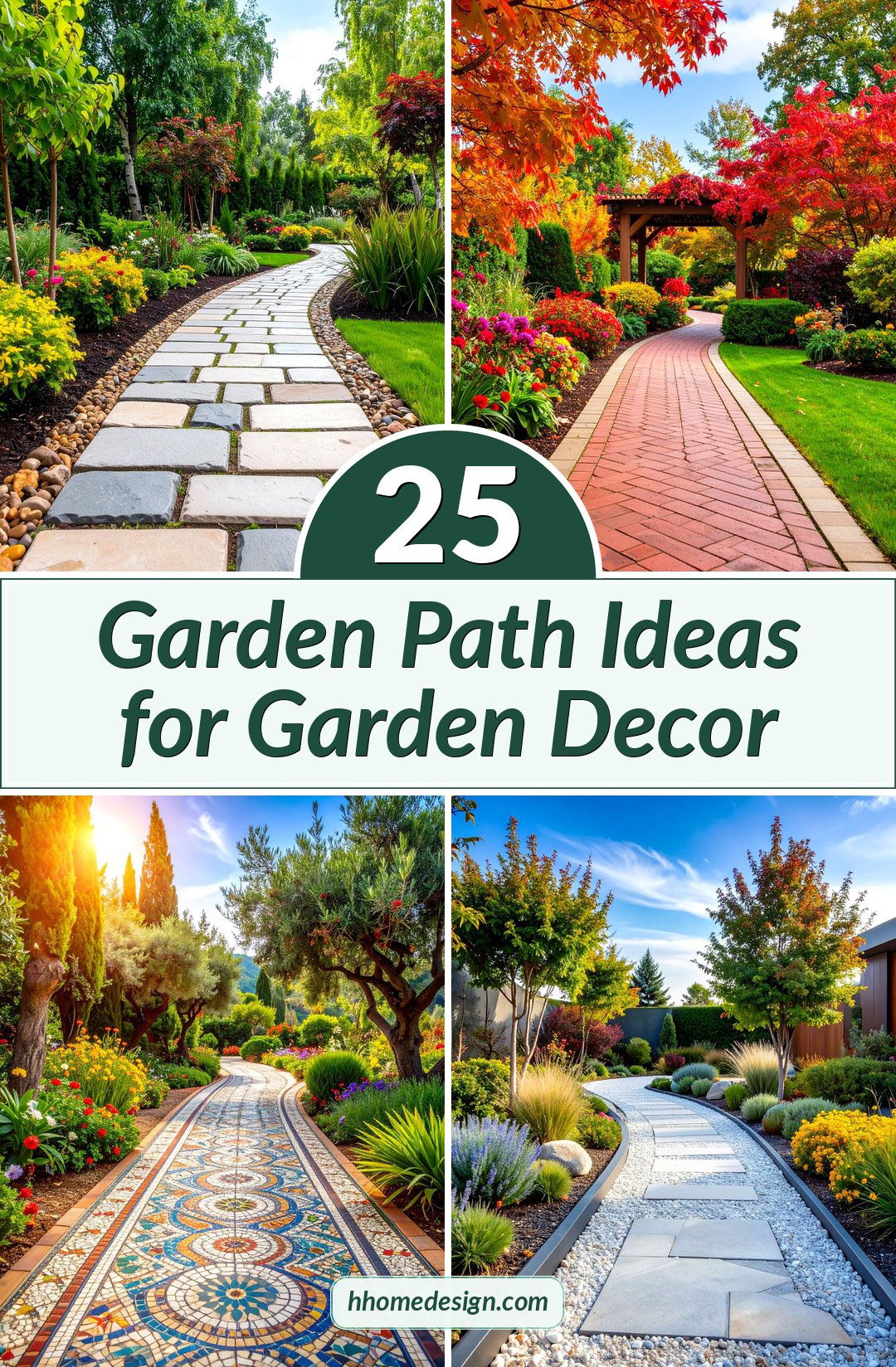
1. Natural Stone Slate Garden Path with Moss Accents
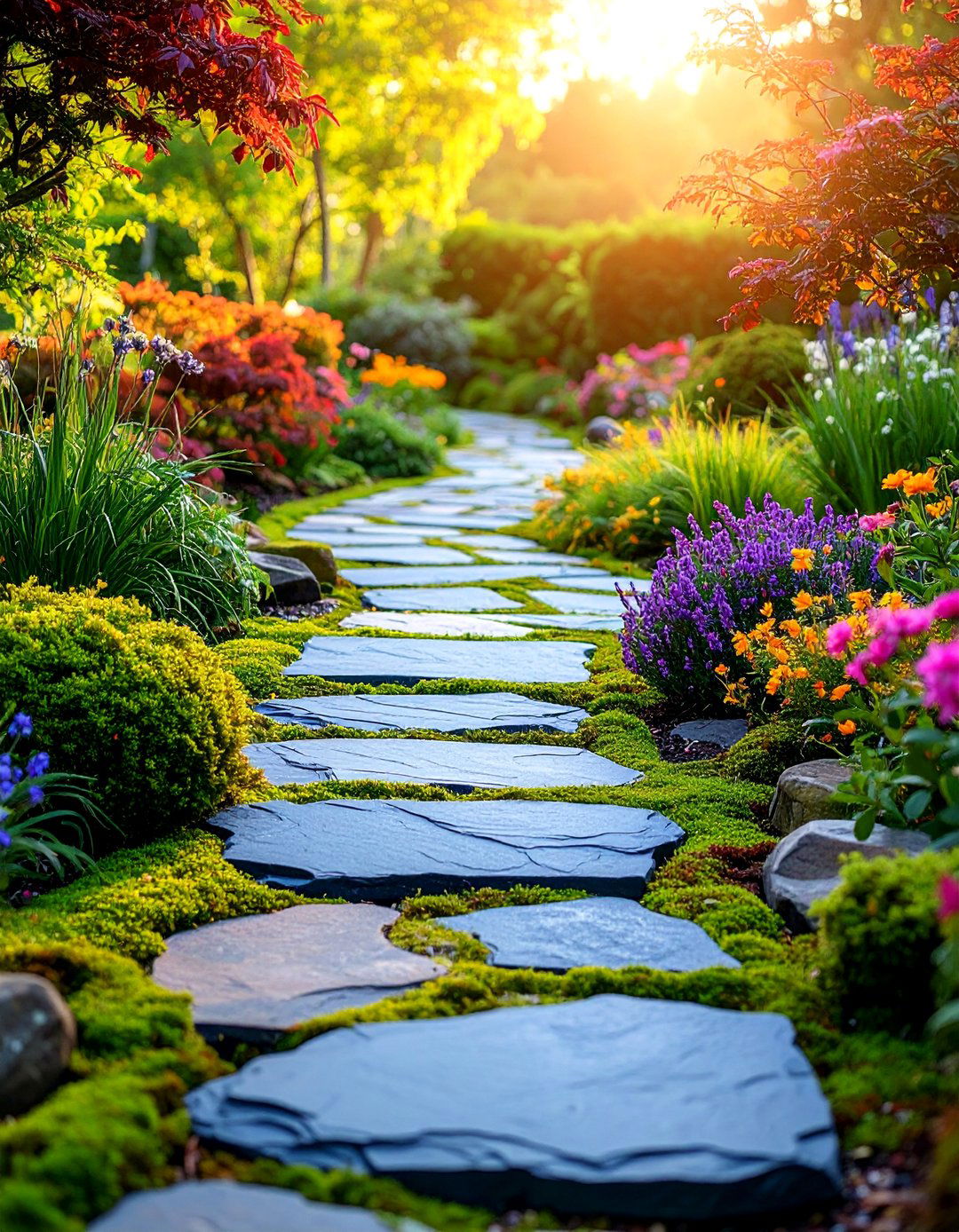
Natural slate creates an elegant pathway that seamlessly blends with garden surroundings through its cool grey-blue tones and varied textures. These durable stones offer rectangular and rounded edge options, allowing for both formal and organic layout possibilities. The natural variations in slate coloring provide visual interest while maintaining sophistication throughout the seasons. Installing slate pieces involves minimal cutting, making this approach accessible for DIY enthusiasts seeking professional results. The stones naturally accommodate moss growth between joints, creating a charming aged appearance that enhances the garden's established feel. Slate's slip-resistant surface ensures safety during wet conditions while requiring minimal maintenance beyond occasional cleaning.
2. Curved Gravel Garden Path with Brick Edging
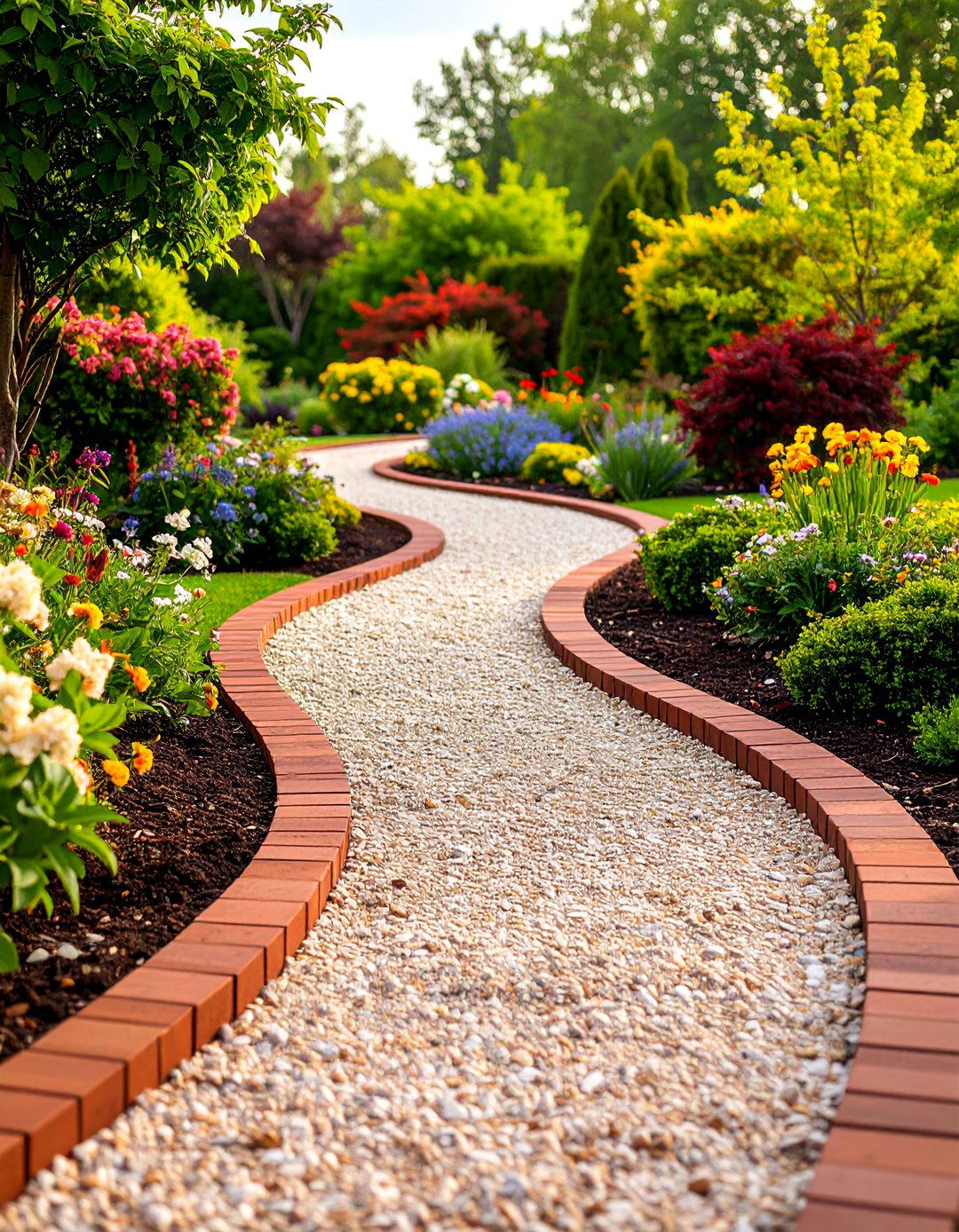
Meandering gravel pathways bordered with traditional brick edging create warm, inviting routes through garden spaces while offering excellent drainage properties. The rich red-brown brick tones beautifully complement natural gravel hues, establishing visual warmth and definition. This design approach allows for gentle curves that make spaces feel larger and more mysterious by concealing destinations. Gravel provides satisfying textural sounds underfoot while remaining cost-effective and easy to install. The brick edging prevents material spillage onto surrounding lawns and garden beds while adding structural integrity. Regular maintenance involves occasional raking and periodic gravel replenishment to maintain the path's neat appearance and proper drainage function.
3. Large Concrete Stepping Stones Through Grass
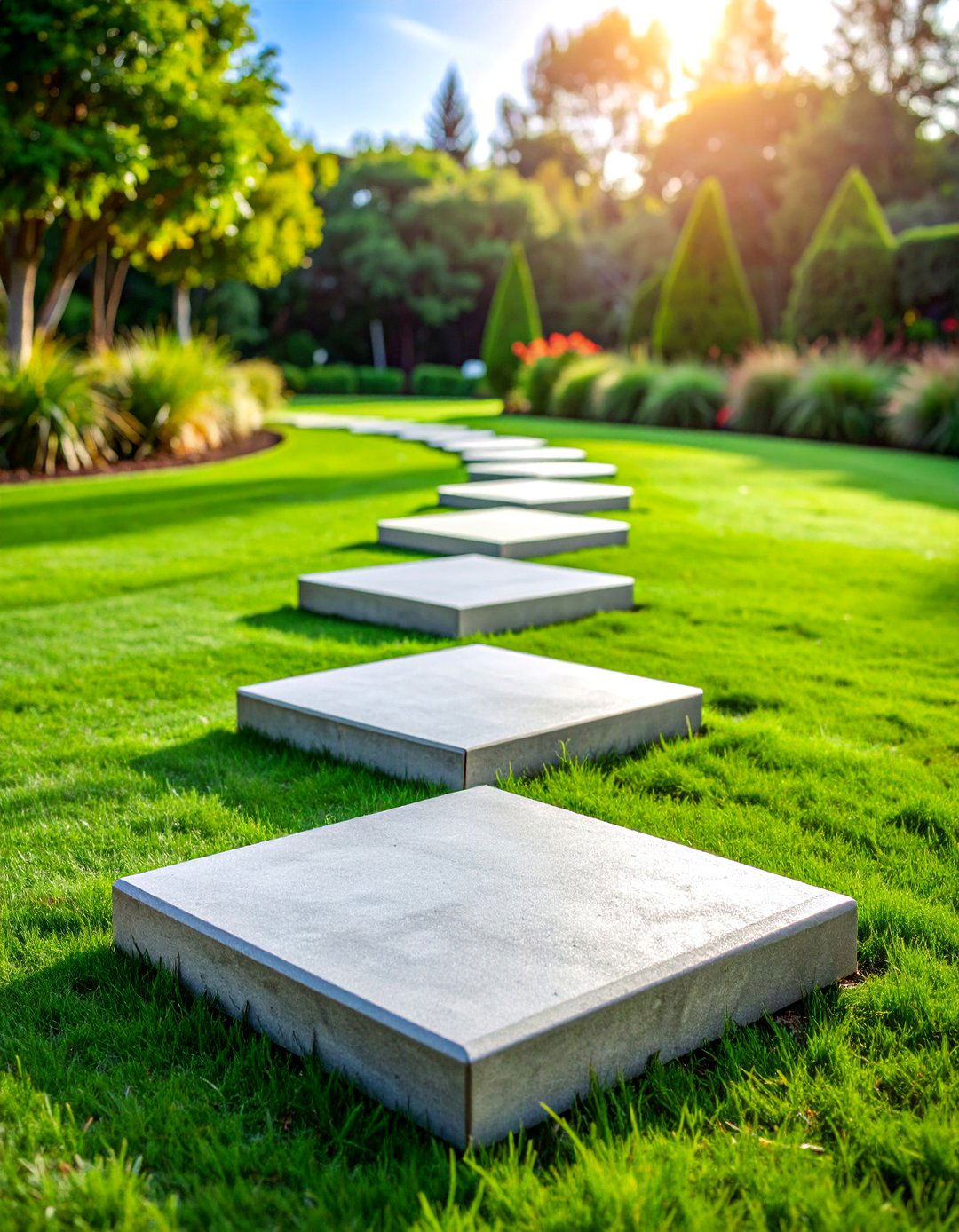
Oversized concrete stepping stones create modern, minimalist pathways that appear to float across lush grass lawns with sophisticated simplicity. These substantial pavers can be positioned at comfortable walking intervals, typically eighteen to twenty-four inches apart for natural gait patterns. The clean geometric shapes provide contemporary appeal while allowing grass to grow between stones, maintaining landscape continuity. Custom molds enable homeowners to create unique shapes, sizes, and surface textures that reflect personal style preferences. This approach works exceptionally well for connecting different garden areas without creating visual barriers. Concrete's durability ensures long-lasting performance while the floating effect adds dynamic visual interest to otherwise plain lawn areas.
4. Wooden Plank Walkway with White Gravel Borders

Horizontal wooden planks create striking contemporary garden paths when surrounded by pristine white gravel beds that enhance clean, modern aesthetics. This design combination offers warmth through natural wood tones while maintaining sophisticated simplicity through geometric arrangements. Treated lumber or composite materials provide weather resistance and longevity in outdoor conditions. The contrasting white gravel creates sharp definition while reflecting light to brighten shaded pathway areas. Installation involves creating level foundations with proper drainage to prevent water accumulation under wooden surfaces. Regular maintenance includes periodic wood treatment and gravel cleaning to preserve the pathway's crisp appearance and structural integrity throughout changing seasons.
5. Mixed-Size Flagstone Path with Pebble Gaps

Irregular flagstone pieces arranged in organic patterns with smooth pebble joints create naturally beautiful pathways that complement informal garden designs perfectly. This approach celebrates stone's natural variations in size, shape, and color while providing stable walking surfaces. The pebble-filled gaps between stones enhance drainage while adding textural contrast and visual softness. Flagstone's durability withstands heavy foot traffic and weather extremes while developing attractive patina over time. The random arrangement eliminates complex cutting requirements, making installation more straightforward for DIY projects. This design works particularly well in cottage gardens, woodland settings, and rustic landscapes where natural materials harmonize with surrounding plantings and environmental features.
6. Herringbone Brick Pattern Garden Walkway
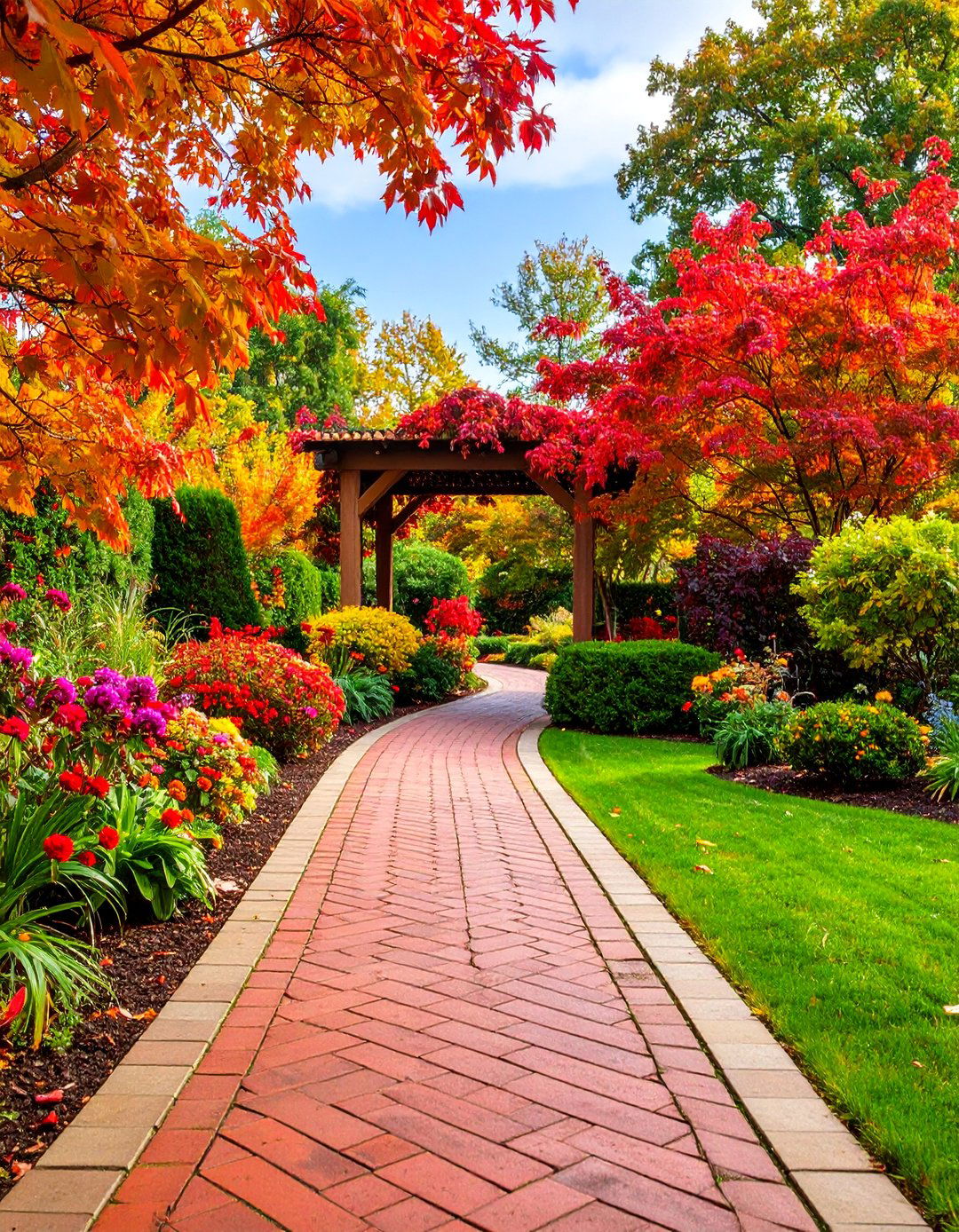
Classic herringbone brick patterns create timeless pathways that deliver both elegance and exceptional durability through their interlocking design structure. This traditional arrangement involves laying bricks at ninety-degree angles in zigzag formations that provide superior stability and visual interest. The pattern's strength makes it ideal for high-traffic areas while its classic appeal complements both historical and contemporary architectural styles. Installation requires careful planning and precise placement to achieve clean, professional results that enhance property values. Regular maintenance involves occasional sand replenishment between joints and periodic cleaning to remove moss or algae buildup. The herringbone pattern's enduring popularity stems from its proven performance and sophisticated appearance.
7. Decomposed Granite Path with Steel Edging

Decomposed granite creates firm, natural-looking pathways that offer excellent compaction properties while maintaining permeable surfaces for sustainable drainage. This finely crushed stone material packs tightly when properly installed, creating smooth walking surfaces that accommodate wheelchairs and strollers easily. Steel edging provides clean, precise borders that prevent material migration while adding contemporary linear elements to garden designs. The neutral earth tones complement diverse planting schemes without competing for visual attention. Installation involves proper base preparation and compaction techniques to ensure long-term stability and performance. Regular maintenance requires occasional surface raking and periodic material addition to maintain optimal thickness and appearance throughout weather cycles.
8. Circular Stepping Stone Path Through Mulch

Round stepping stones strategically placed through organic mulch beds create charming, informal pathways that encourage leisurely garden exploration and plant observation. This approach works exceptionally well in woodland gardens, shade areas, and naturalistic landscapes where curved routes feel more appropriate than rigid lines. Various mulch materials including bark chips, leaf mold, or wood shavings provide soft, natural surfaces between stones. The circular stone shapes offer generous footing while their spacing allows for comfortable walking rhythms. Mulch requires periodic replenishment as organic materials decompose, contributing beneficial nutrients to surrounding soil areas. This cost-effective design approach provides immediate results while supporting long-term garden health through natural soil improvement processes.
9. Crushed Shell Coastal Garden Path
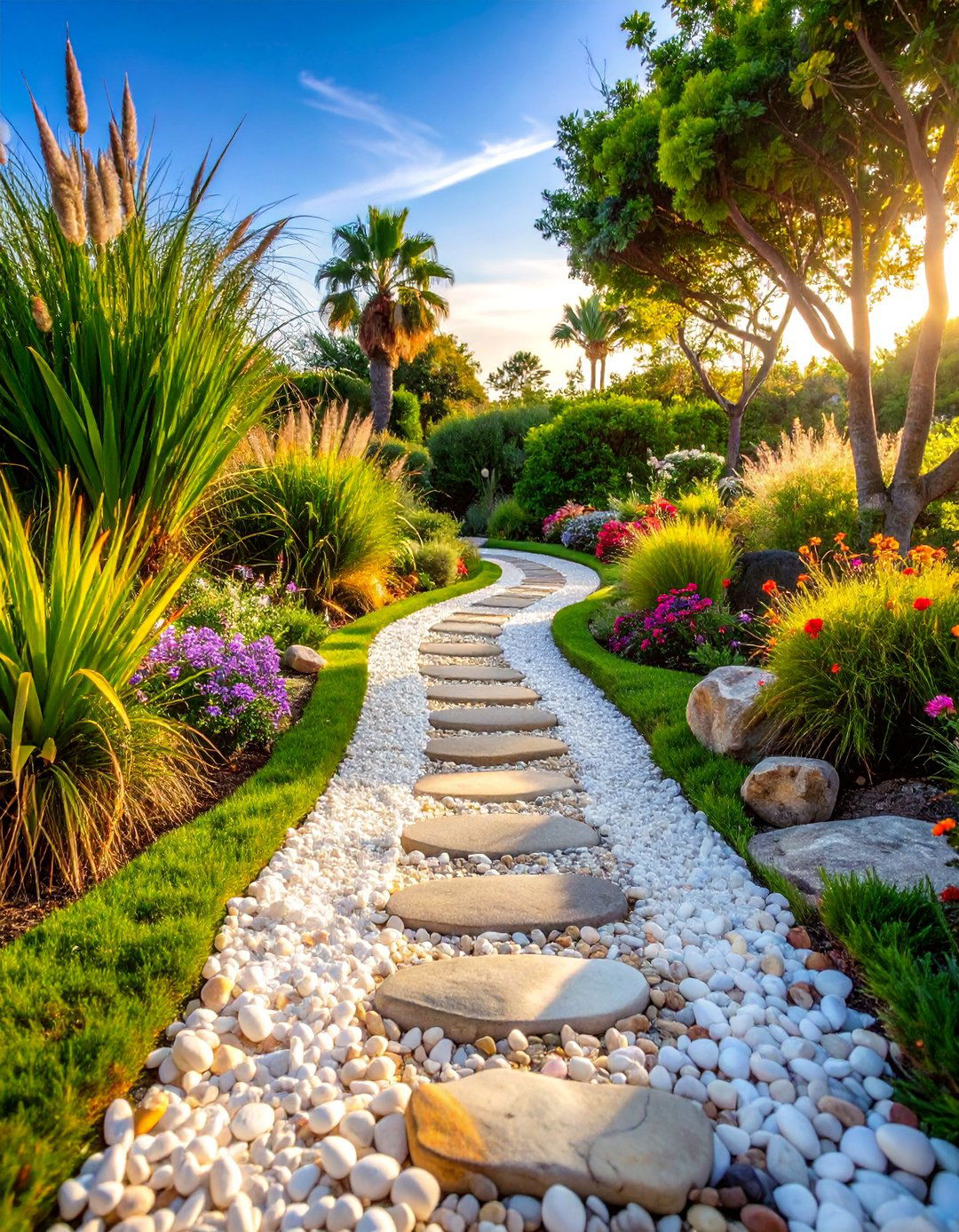
Crushed shell pathways bring coastal charm to garden spaces while providing excellent drainage and natural calcium supplementation for surrounding plants. These materials create light-colored surfaces that reflect sunlight and stay cooler than dark alternatives during hot weather. Shell pathways complement beachside gardens, Mediterranean themes, and informal cottage designs with their organic textures and oceanic associations. The crunching sound underfoot adds sensory appeal while alerting homeowners to approaching visitors for natural security benefits. Installation requires proper base preparation and edging to prevent material displacement during storms or heavy rains. Regular maintenance involves occasional raking and periodic shell addition to maintain desired thickness and appearance while supporting proper drainage throughout seasonal weather changes.
10. Reclaimed Brick Path with Wild Thyme Joints
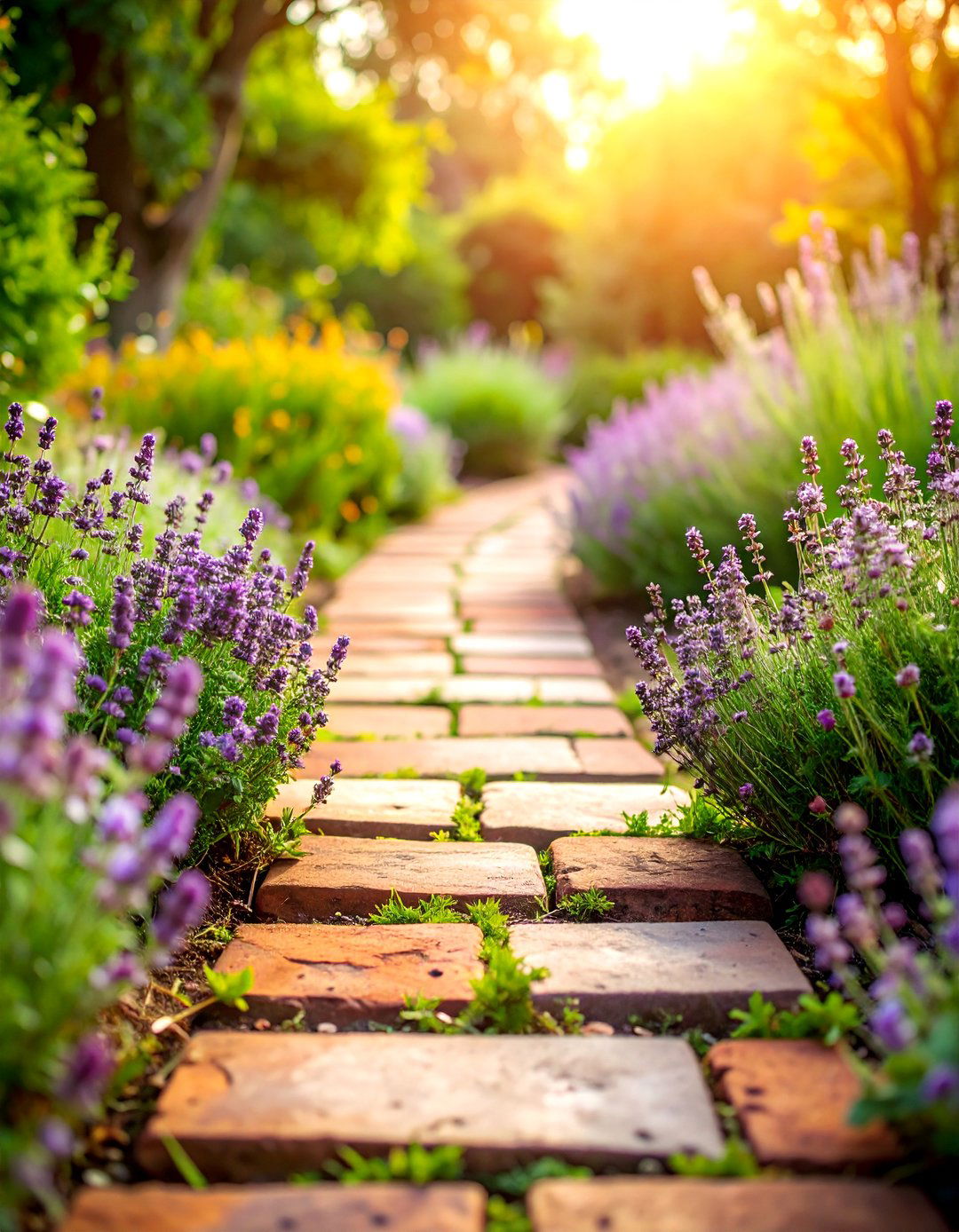
Weathered reclaimed bricks create characterful pathways with aged patina and historical charm that new materials cannot replicate authentically. The irregular edges and varied coloring of old bricks provide rustic appeal while their proven durability ensures decades of reliable service. Planting wild thyme or other aromatic herbs between brick joints creates living pathways that release pleasant fragrances when walked upon. This approach combines hardscaping with softscaping elements for integrated garden design that supports beneficial insects and pollinators. Installation involves careful selection and arrangement of suitable reclaimed materials while ensuring structural stability. Regular maintenance includes herb trimming and occasional brick releveling to maintain safe, attractive surfaces that improve with age and weathering.
11. Permeable Paver Path with Grass Strips

Permeable paving systems with integrated grass strips create environmentally sustainable pathways that manage stormwater runoff while maintaining green space continuity. These specialized pavers feature open structures that allow water infiltration and grass growth through designed openings. The combination reduces impervious surface area while providing stable walking surfaces for regular use. This approach satisfies environmental regulations while creating visually interesting patterns that change with seasonal grass growth cycles. Installation requires proper base preparation and drainage systems to ensure optimal performance during heavy rainfall events. Regular maintenance involves grass care within paver openings and occasional joint cleaning to prevent clogging and maintain proper water infiltration rates throughout the pathway system.
12. Stamped Concrete Path with Leaf Patterns
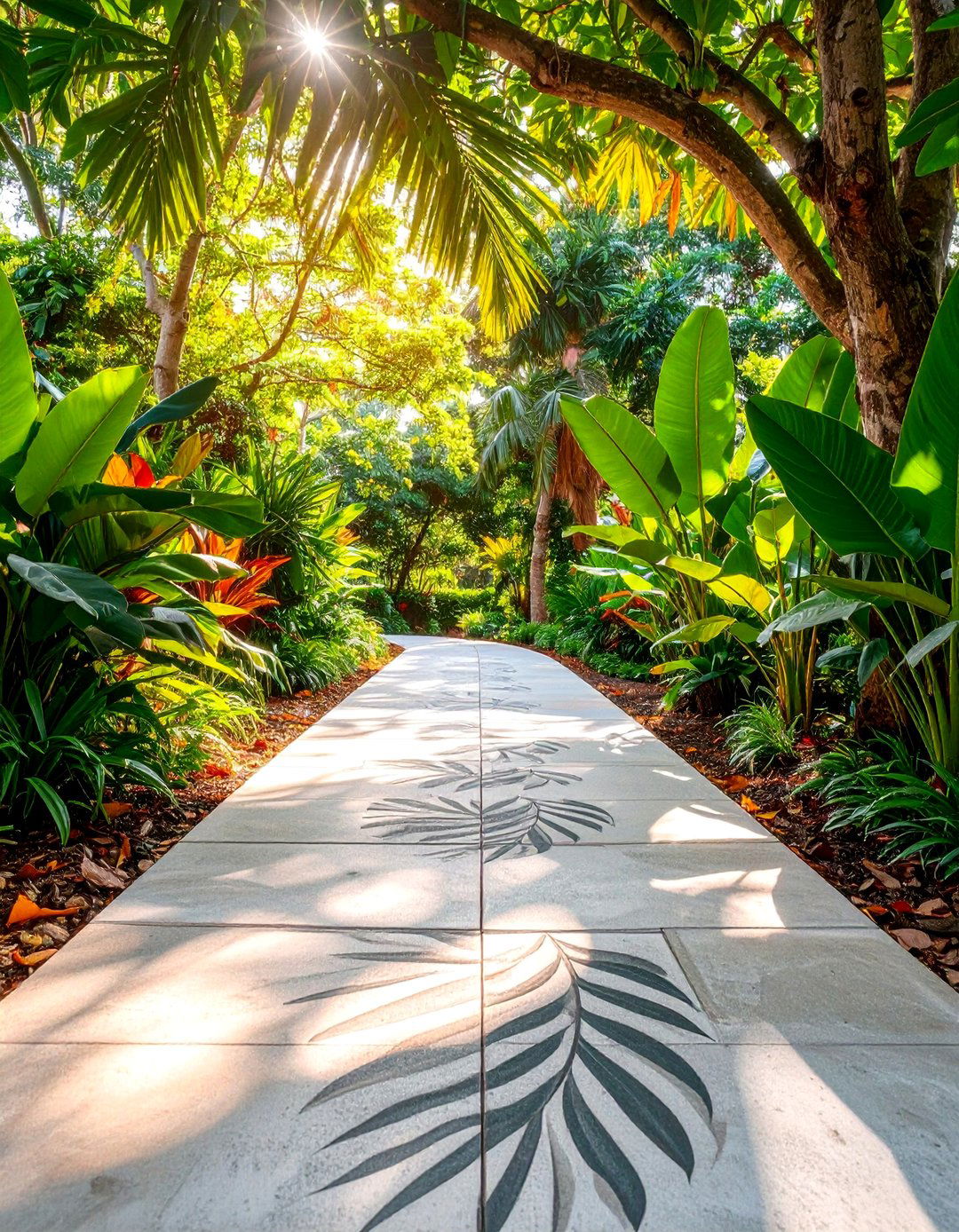
Decorative stamped concrete pathways mimic natural materials while offering superior durability and customization options through various patterns and color choices. Leaf-pattern stamps create organic textures that complement garden environments while providing slip-resistant surfaces for safe walking. This technique allows for complex designs including borders, focal points, and transitional areas that enhance overall landscape aesthetics. Proper installation involves timing concrete placement with weather conditions and achieving consistent stamping depth and pressure. Integral colors and surface stains provide long-lasting appearance that resists fading and wear. Regular maintenance includes periodic sealing to protect surface integrity and occasional cleaning to remove stains or organic debris that might accumulate in textured areas.
13. River Rock Mosaic Stepping Stones
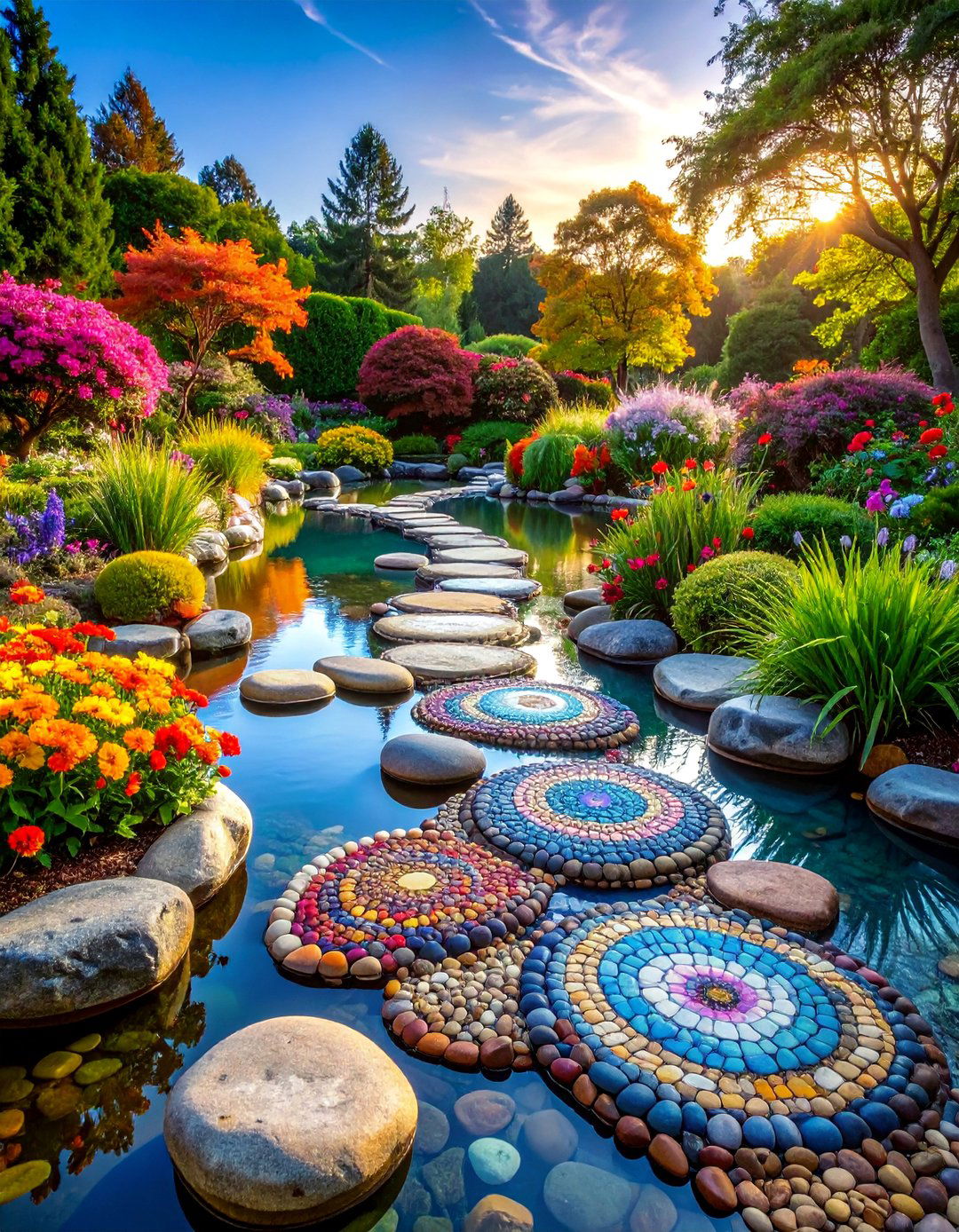
Handcrafted mosaic stepping stones using river rocks create artistic pathway elements that showcase natural stone beauty while providing unique focal points throughout garden spaces. These custom installations allow for personal expression through color selection, pattern design, and stone arrangement techniques. The smooth, rounded river rocks offer comfortable walking surfaces while their varied sizes enable intricate designs and detailed patterns. Each stepping stone becomes a miniature work of art that enhances garden character and reflects creator personality. Installation involves concrete base preparation and careful stone placement to achieve level surfaces and desired aesthetic effects. Regular maintenance includes occasional cleaning and minor stone adjustment to maintain pattern integrity and surface levelness throughout weather exposure.
14. Bluestone Path with Groundcover Plantings

Bluestone pathways provide sophisticated elegance through their consistent coloring and fine-grained textures that complement both formal and informal garden designs effectively. The stone's natural blue-grey tones create calming visual effects while providing excellent weather resistance and minimal maintenance requirements. Groundcover plantings between stones soften hardscape edges while adding seasonal interest and supporting local ecosystem health. Popular choices include creeping thyme, moss, and low-growing sedums that tolerate foot traffic. Installation requires level base preparation and precise stone placement to ensure proper drainage and stability. Regular maintenance involves groundcover care and occasional stone cleaning to prevent moss buildup and maintain the pathway's refined appearance throughout changing seasons.
15. Cobblestone Path with Drainage Channels

Traditional cobblestone pathways enhanced with integrated drainage channels provide historical character while addressing modern water management requirements effectively. These time-tested surfaces offer exceptional durability and slip resistance while creating distinctive visual textures that improve with age. Proper drainage prevents water accumulation and ice formation during winter months while protecting surrounding landscape areas from erosion. The irregular cobblestone surfaces slow pedestrian traffic naturally, encouraging garden observation and contemplation. Installation requires skilled craftsmanship to achieve proper grading and joint stability for long-term performance. Regular maintenance involves channel cleaning and occasional stone resetting to maintain proper water flow and surface levelness throughout the pathway system's operational life.
16. Geometric Concrete Pavers with Sand Joints

Modern geometric concrete pavers arranged in precise patterns create contemporary pathway designs that emphasize clean lines and minimalist aesthetics perfectly. These manufactured units offer consistent sizing and coloring while providing exceptional durability and load-bearing capacity for various applications. Sand-filled joints allow for thermal expansion while preventing weed growth and maintaining pattern integrity. The geometric shapes can be arranged in multiple configurations to create visual interest and directional emphasis. Installation involves careful base preparation and precise placement to achieve professional results that enhance property values. Regular maintenance includes occasional sand replenishment and surface cleaning to maintain appearance and structural performance throughout weather cycles and seasonal changes.
17. Tree Trunk Stepping Stones Through Bark Mulch

Rustic tree trunk sections create unique stepping stones that bring woodland character to garden pathways while utilizing natural materials sustainably. These organic rounds provide generous walking surfaces with natural slip resistance through their textured bark surfaces. Bark mulch surrounding the trunk sections creates cohesive forest floor aesthetics while providing soft landing areas and moisture retention. This approach works particularly well in shade gardens, woodland settings, and children's play areas where natural materials enhance outdoor experiences. Installation involves selecting properly seasoned wood and ensuring level placement for safety and stability. Regular maintenance includes bark mulch replenishment and periodic trunk inspection to ensure continued structural integrity and safety performance.
18. Gravel Path with Solar LED Strip Lighting

Illuminated gravel pathways featuring solar LED strip lighting create magical evening ambiance while providing essential safety lighting for nighttime navigation. The embedded lighting follows pathway curves and highlights garden features while remaining energy-efficient and environmentally sustainable. Warm LED colors create inviting atmospheres while cool colors provide crisp, modern aesthetics depending on design preferences. Solar charging eliminates electrical installation requirements while providing reliable operation throughout evening hours. Quality gravel provides excellent drainage while supporting light installation and maintenance access. Regular maintenance involves occasional gravel raking and light cleaning to ensure optimal performance and appearance throughout seasonal weather changes and usage patterns.
19. Mixed Material Path with Stone and Wood

Creative combinations of stone and wood materials create dynamic pathways that showcase contrasting textures while providing varied walking experiences throughout garden journeys. Alternating sections highlight each material's unique properties while creating visual rhythm and directional emphasis. Stone sections provide durability and weather resistance while wooden elements add warmth and natural character. This approach allows for curved designs that accommodate both materials' installation requirements and aesthetic contributions. Proper planning ensures smooth transitions between materials while maintaining consistent pathway widths and safety standards. Regular maintenance involves material-specific care including wood treatment and stone cleaning to preserve appearance and performance characteristics throughout changing environmental conditions and usage levels.
20. Mosaic Tile Path with Mediterranean Patterns

Artistic mosaic pathways featuring Mediterranean-inspired patterns create stunning focal points that transform ordinary garden routes into decorative masterpieces with lasting appeal. Colorful ceramic tiles arranged in traditional designs bring cultural richness and artistic expression to outdoor spaces while providing durable walking surfaces. These installations require careful planning and skilled craftsmanship to achieve professional results that withstand weather exposure and foot traffic. Pattern designs can incorporate family symbols, geometric motifs, or nature themes that reflect personal interests and garden character. Installation involves concrete base preparation and precise tile placement to ensure longevity and safety. Regular maintenance includes occasional cleaning and minor grout repair to preserve artistic integrity and structural performance throughout the pathway's lifespan.
21. Pine Needle Path with Log Edging
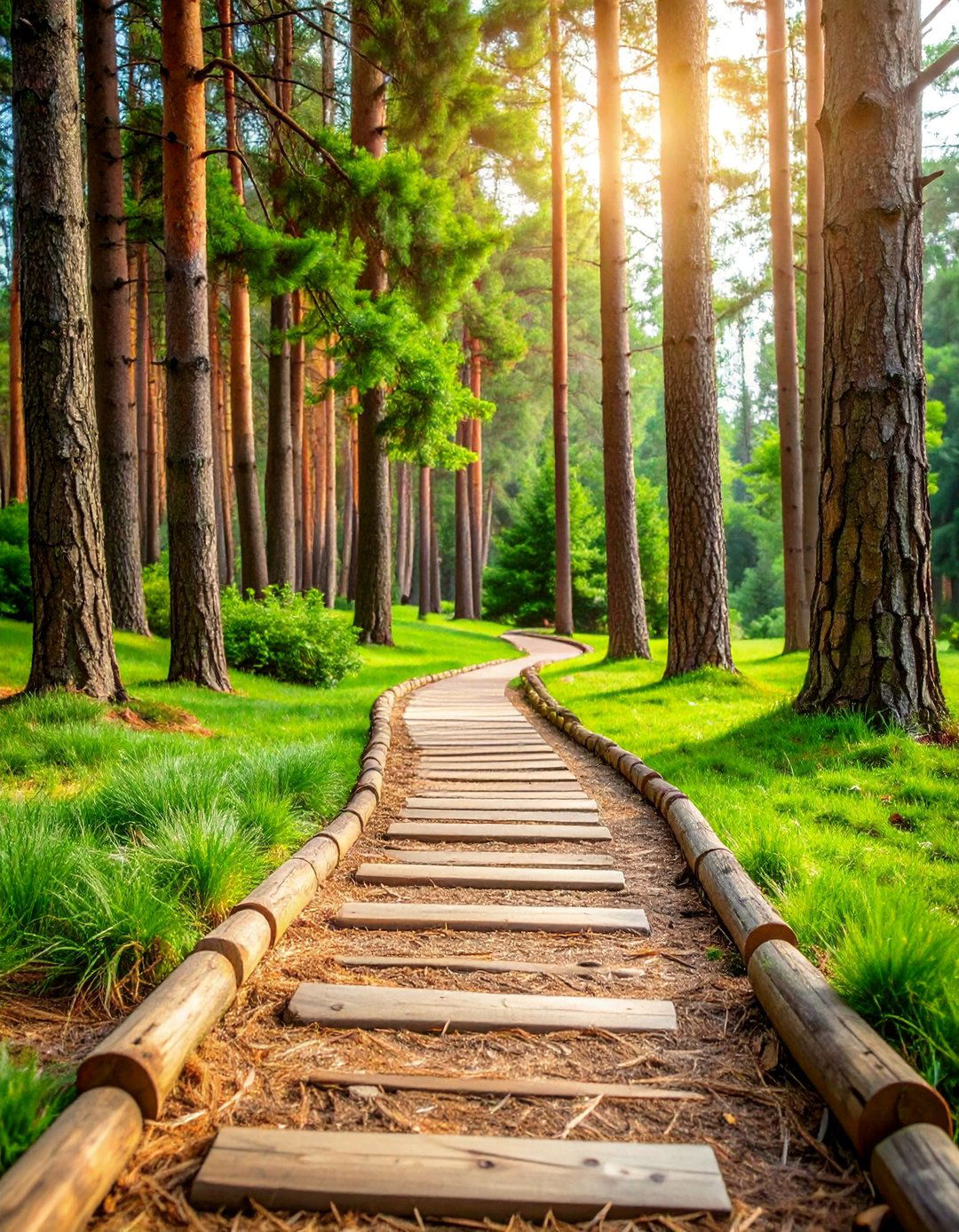
Organic pine needle pathways bordered with natural log edging create soft, aromatic routes through garden spaces while utilizing freely available natural materials sustainably. Fresh pine needles provide cushioned walking surfaces that suppress weeds naturally while releasing pleasant forest fragrances. Log edging defines pathway boundaries while maintaining rustic aesthetics that complement woodland and cottage garden themes. This approach requires minimal installation while providing immediate results that improve with natural settling and weathering. Pine needles decompose gradually, contributing beneficial organic matter to surrounding soil areas while requiring periodic replenishment. Regular maintenance involves needle raking and log adjustment to maintain pathway definition and proper drainage throughout seasonal weather cycles and organic decomposition processes.
22. Slate Chips Path with Ornamental Grass Borders
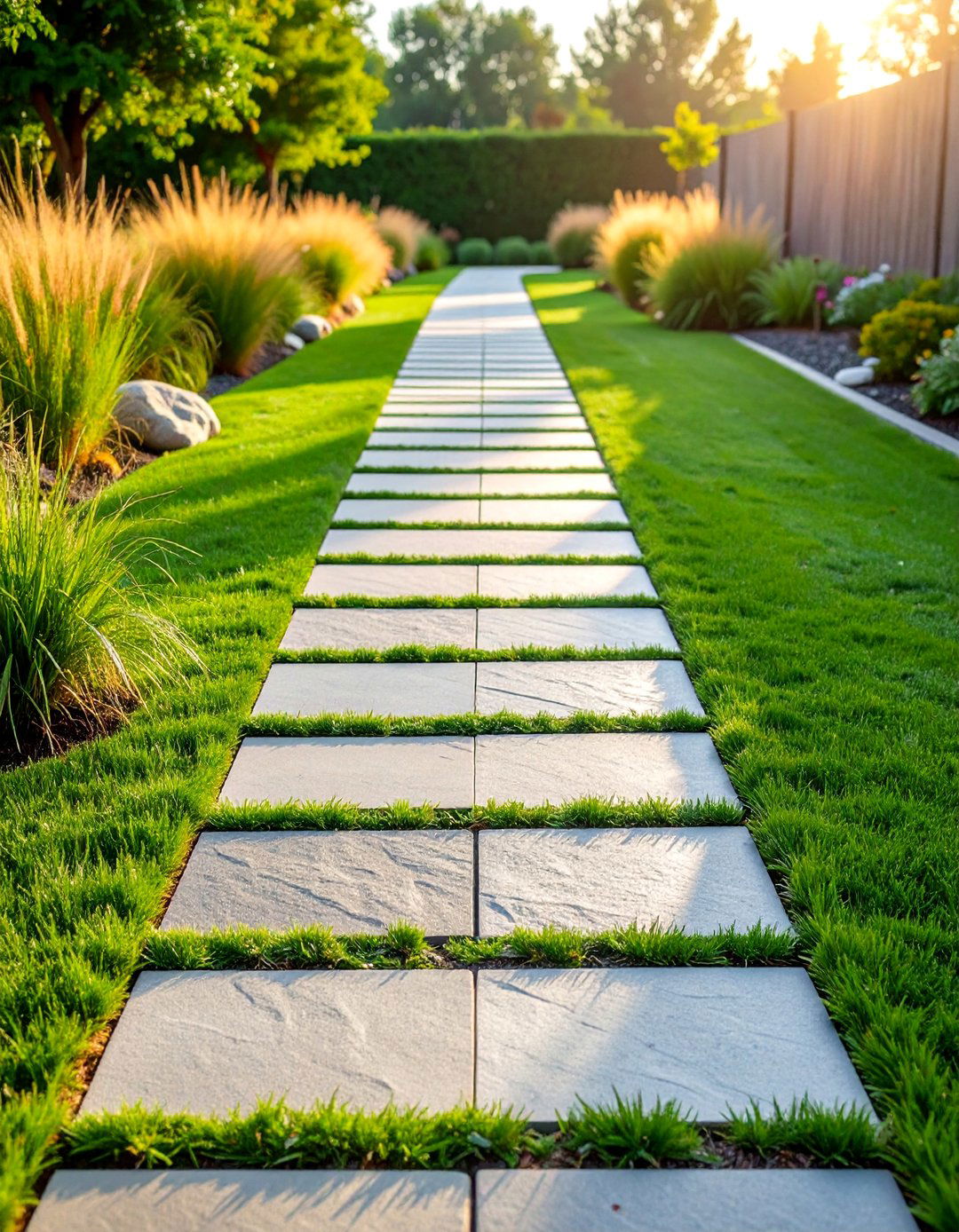
Decorative slate chip pathways enhanced with ornamental grass borders create sophisticated linear elements that provide year-round garden structure and visual interest. The angular slate pieces offer excellent drainage while producing distinctive sounds underfoot that add sensory appeal. Ornamental grasses provide seasonal movement, texture, and color changes that complement the pathway's permanent structure beautifully. This combination works well in contemporary and prairie-style gardens where natural materials create harmonious transitions between hardscape and softscape elements. Installation requires proper base preparation and edging to contain materials effectively while supporting healthy grass establishment. Regular maintenance involves occasional slate raking and grass care to maintain optimal appearance and performance throughout growing seasons.
23. Recycled Glass Path with Concrete Borders
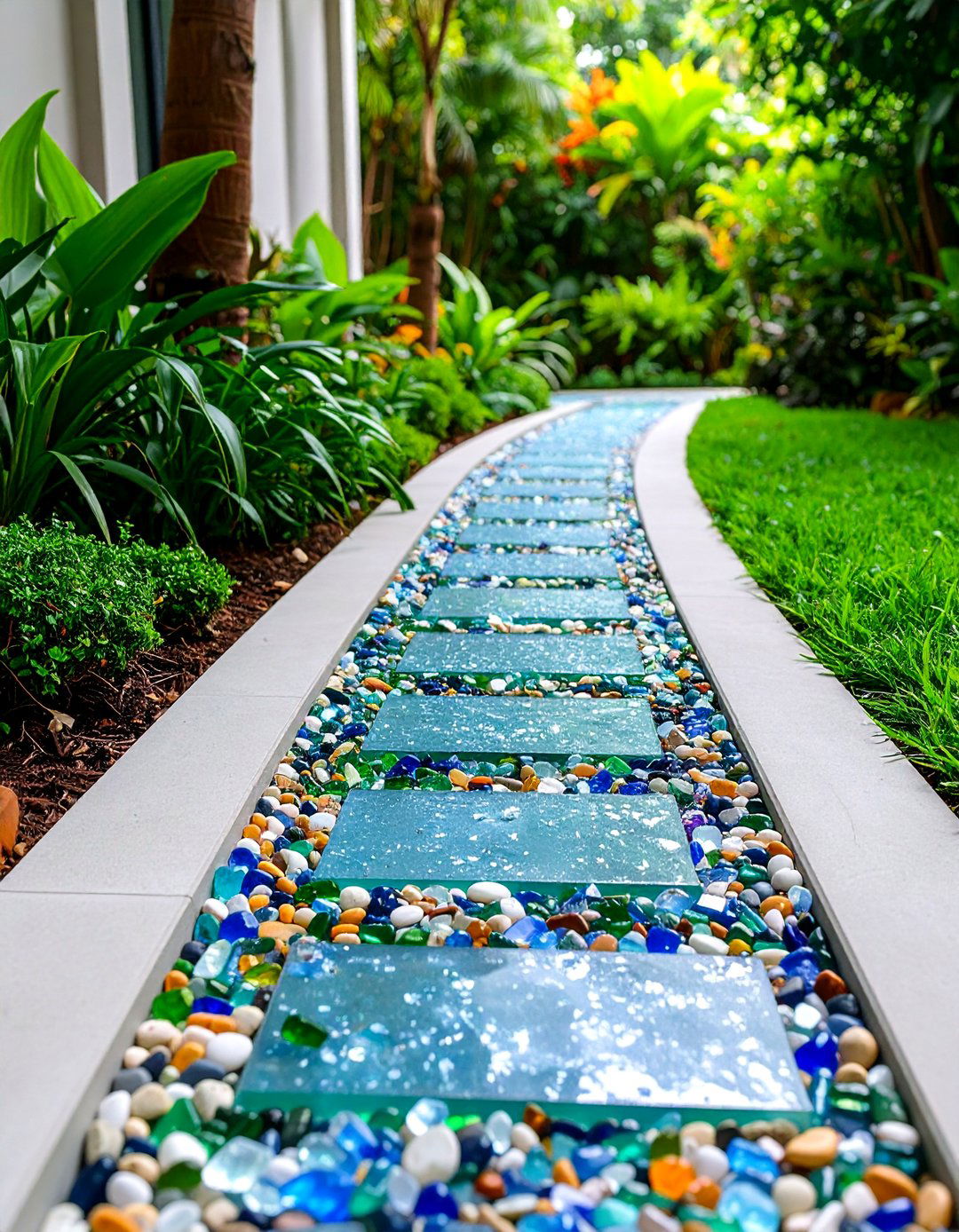
Innovative recycled glass pathways demonstrate environmental stewardship while creating sparkling, light-reflecting surfaces that add contemporary flair to garden designs. Crushed tempered glass provides safe walking surfaces while supporting sustainable building practices through material reuse and waste reduction. Concrete borders contain the glass materials while providing clean, geometric definition that enhances modern landscape aesthetics. Various glass colors can be combined to create custom appearances that complement specific garden color schemes and architectural elements. Installation requires proper base preparation and surface finishing to ensure safety and durability. Regular maintenance involves occasional surface cleaning and minor border repair to maintain appearance and performance characteristics throughout weather exposure and usage patterns.
24. Pebble Mosaic Path with Spiral Designs

Artistic pebble mosaic pathways featuring spiral patterns create meditative walking experiences while showcasing skilled craftsmanship and natural material beauty. These installations combine stones of various sizes and colors to form intricate designs that serve as outdoor art installations. Spiral motifs encourage contemplative movement while adding symbolic meaning related to life cycles and natural growth patterns. Each section requires careful planning and precise placement to achieve desired aesthetic effects and structural integrity. Installation involves concrete base preparation and methodical stone arrangement to ensure pattern continuity and surface levelness. Regular maintenance includes occasional cleaning and minor stone adjustment to preserve artistic integrity and walking safety throughout the pathway's continued use and enjoyment.
25. Combination Brick and Pebble Path with Curved Design

Sophisticated pathway designs combining traditional brick with decorative pebbles create elegant routes that showcase material contrasts while providing varied textural experiences. Curved layouts enhance garden flow while demonstrating advanced design skills that elevate landscape aesthetics significantly. Brick sections provide stable walking surfaces while pebble areas add visual softness and drainage capabilities. This approach allows for creative pattern development that reflects personal style while maintaining practical functionality for regular use. Installation requires careful planning to achieve smooth transitions between materials while ensuring proper drainage and structural stability. Regular maintenance involves material-specific care including brick cleaning and pebble arrangement to preserve the pathway's sophisticated appearance and optimal performance throughout seasonal changes and continued usage.
Conclusion:
Garden paths represent far more than mere functional walkways, serving as artistic expressions that enhance outdoor living while connecting different landscape elements seamlessly. The twenty-five ideas presented offer diverse solutions for varying budgets, skill levels, and aesthetic preferences, ensuring every gardener can find suitable options for their unique spaces. From sustainable recycled materials to sophisticated natural stones, these pathway concepts demonstrate how thoughtful design transforms ordinary gardens into extraordinary outdoor sanctuaries that provide lasting enjoyment and increased property value.



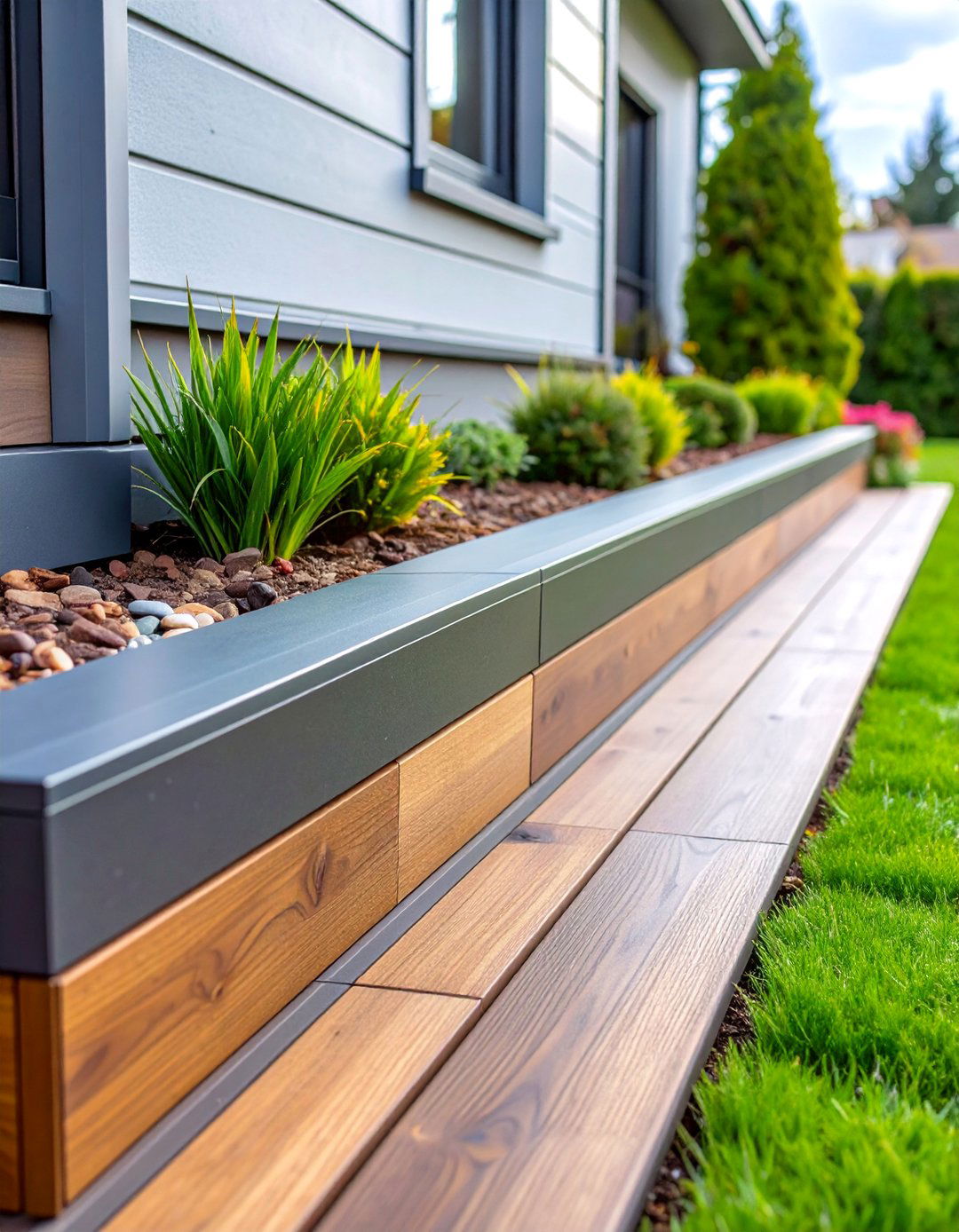
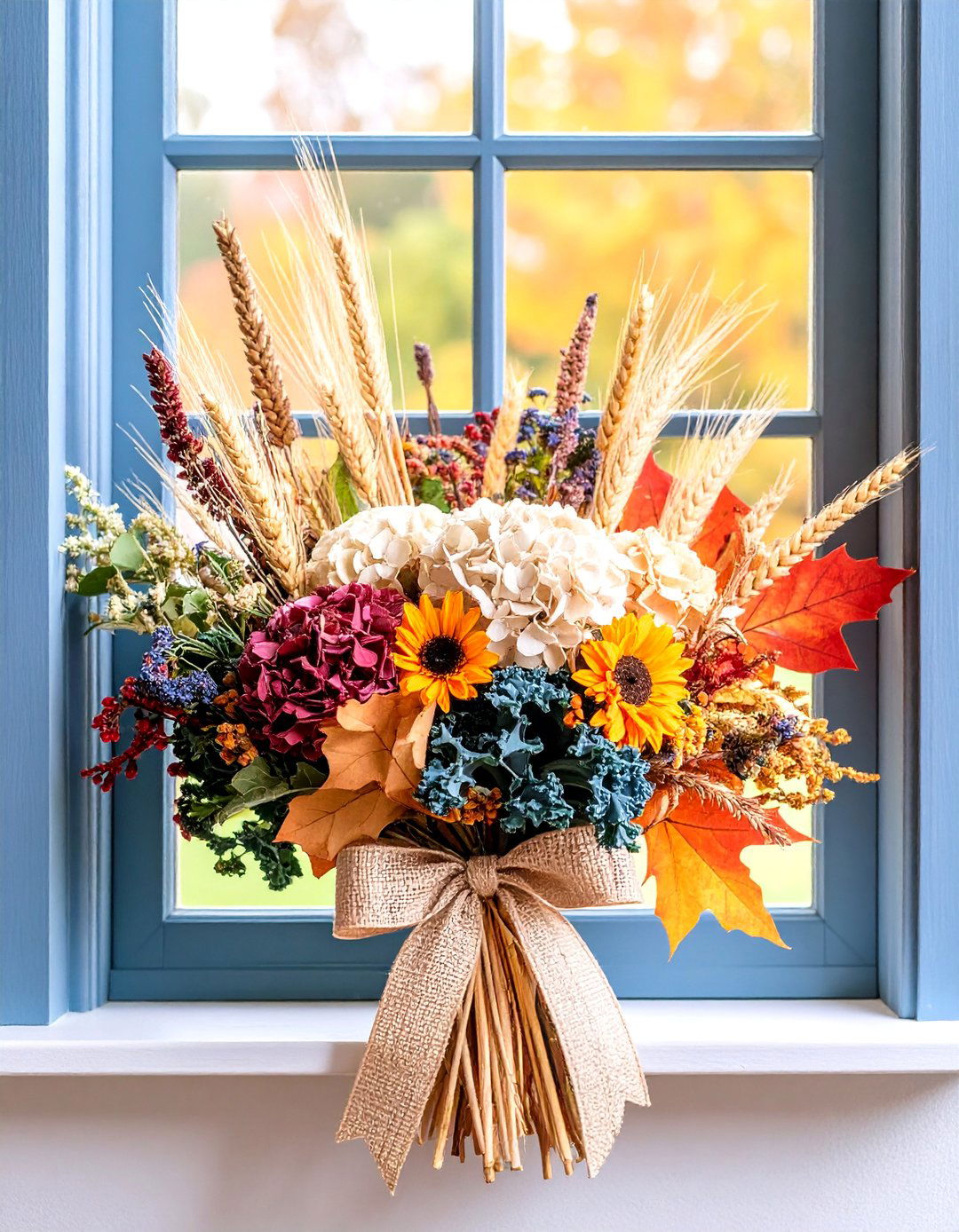

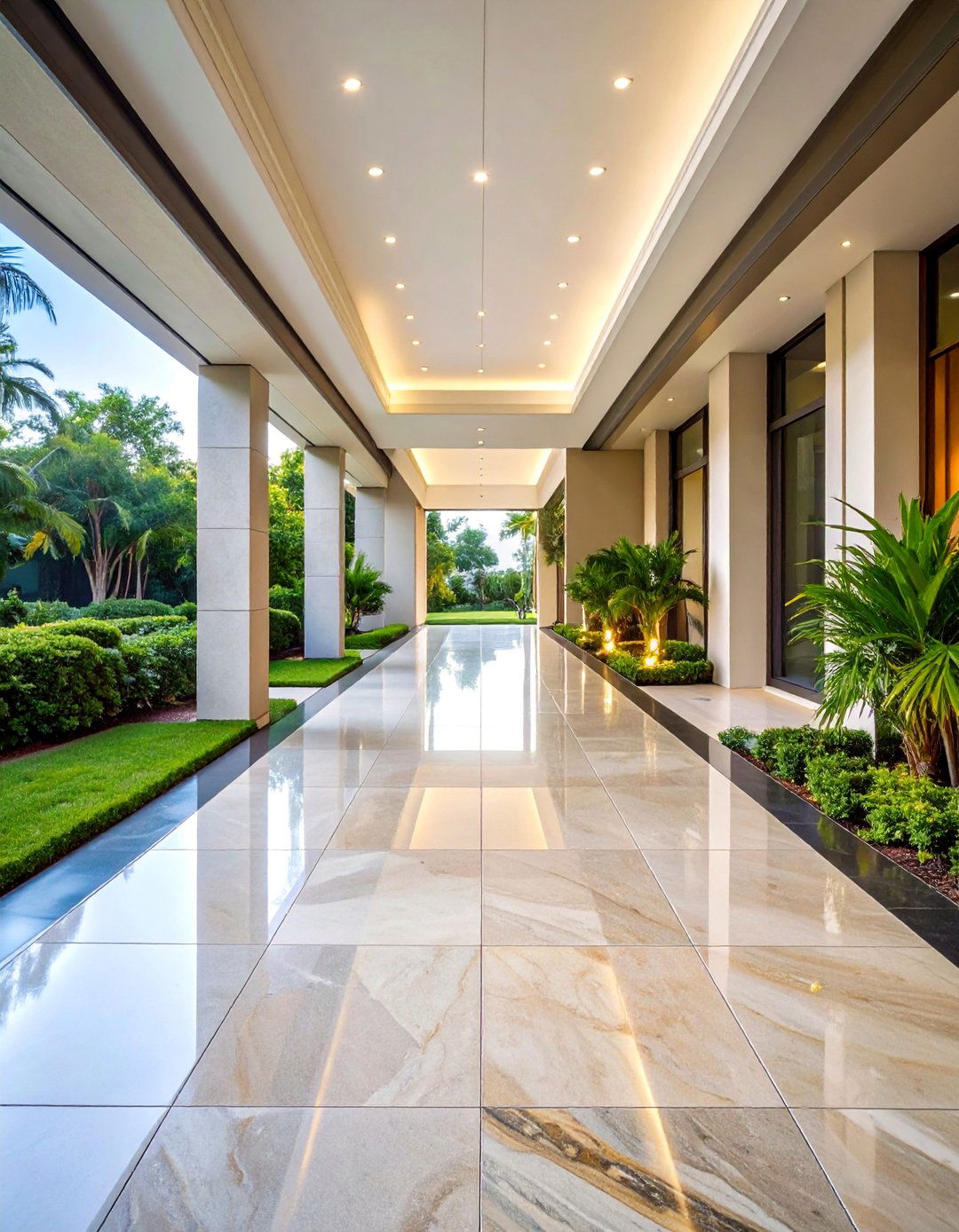
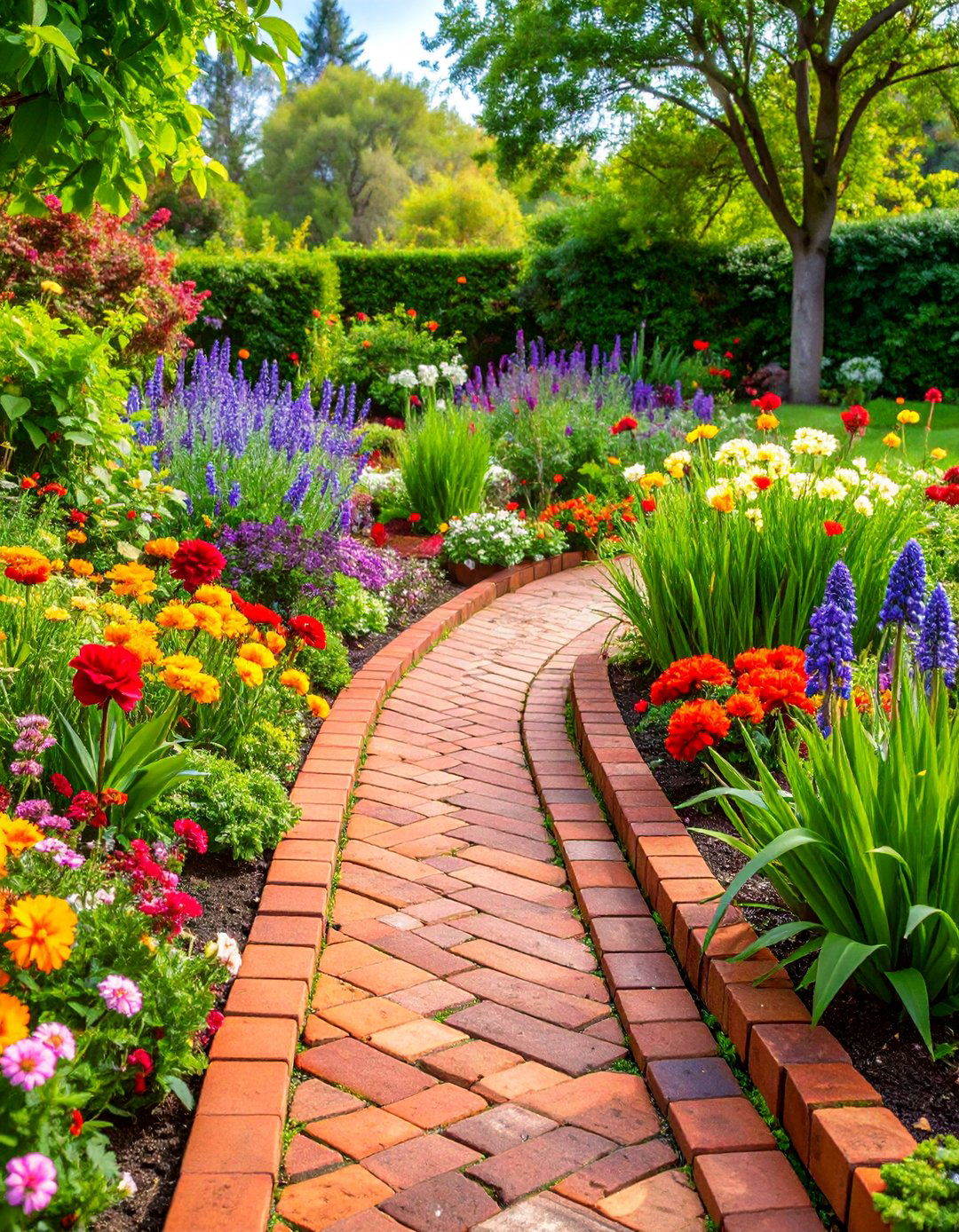

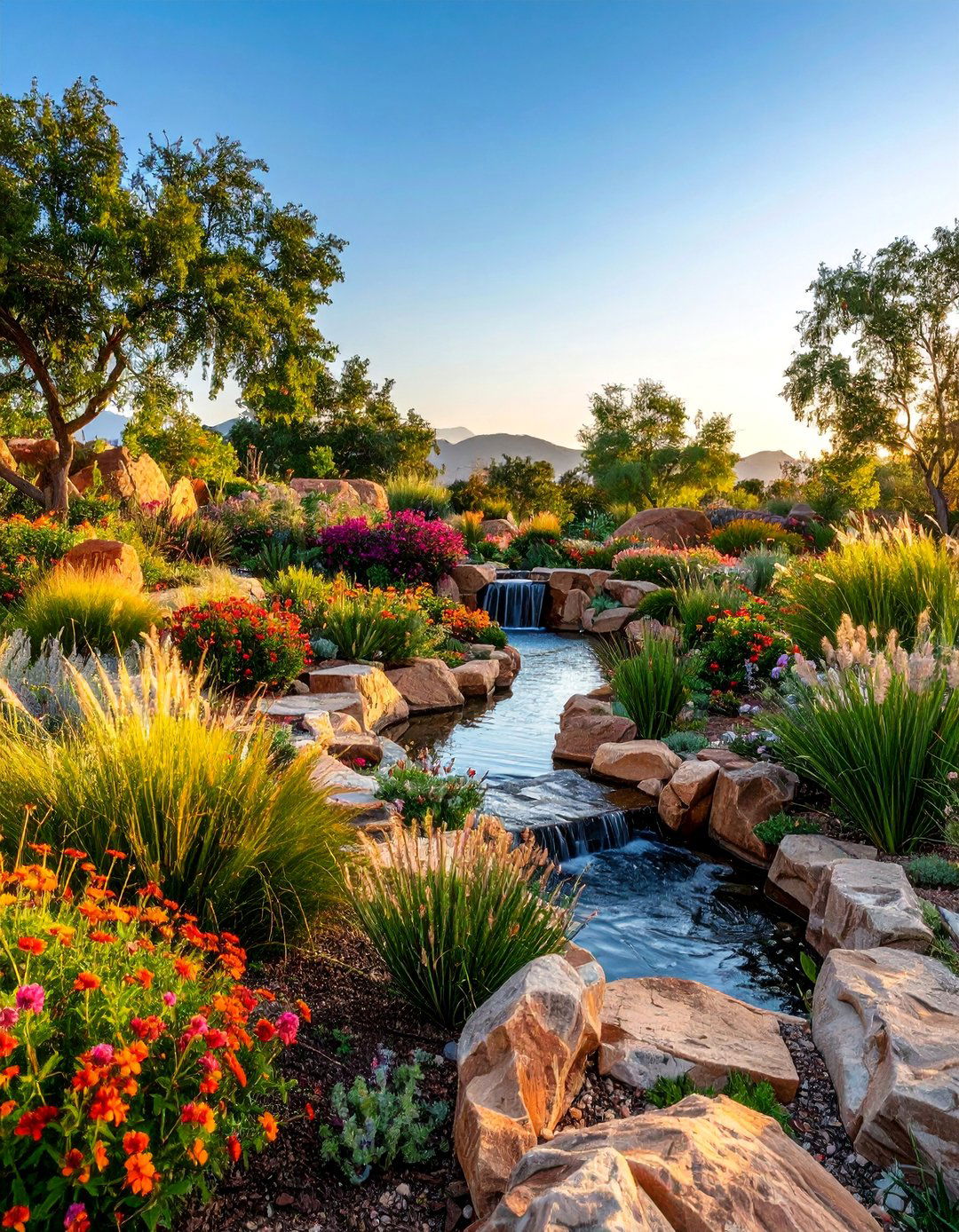
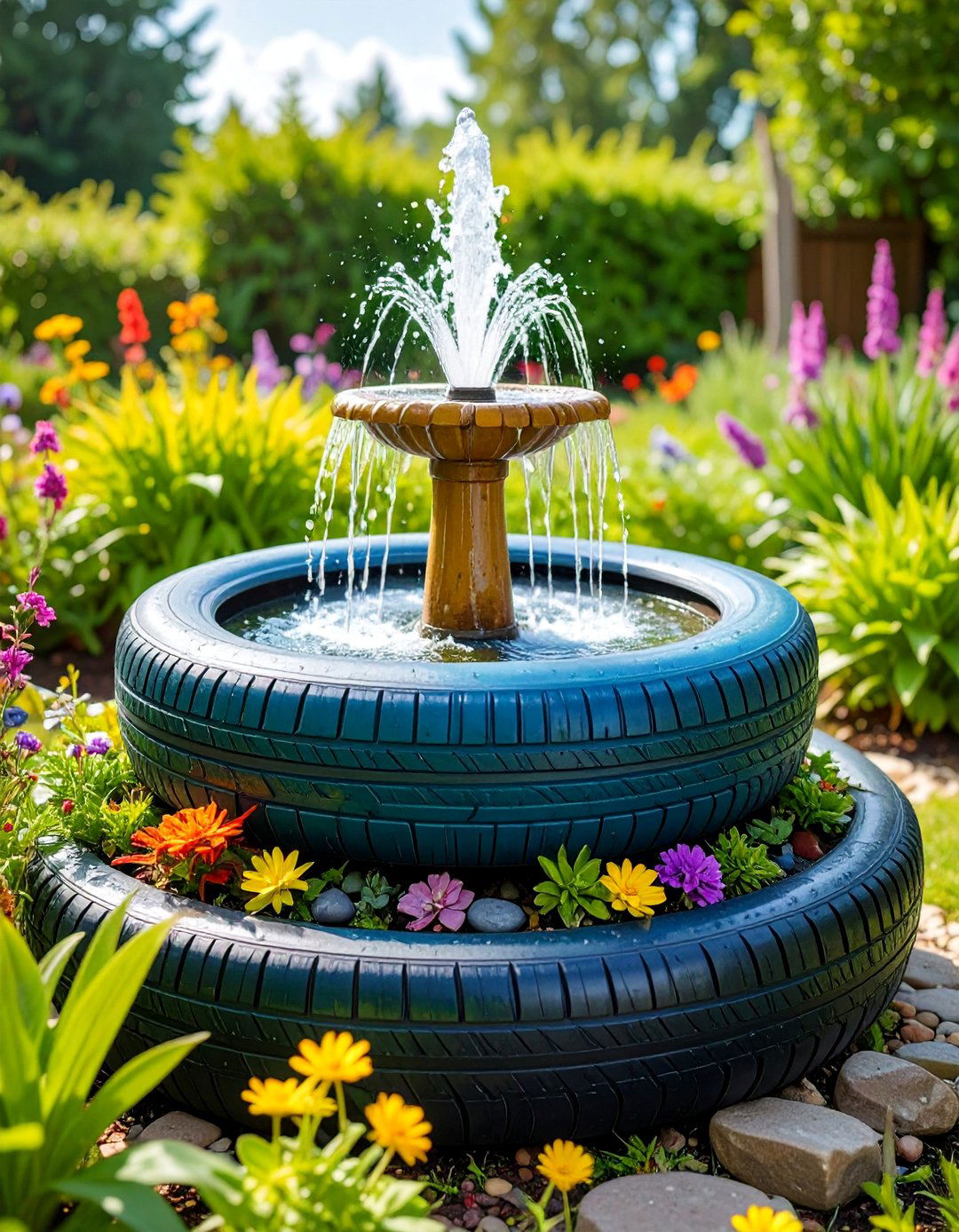


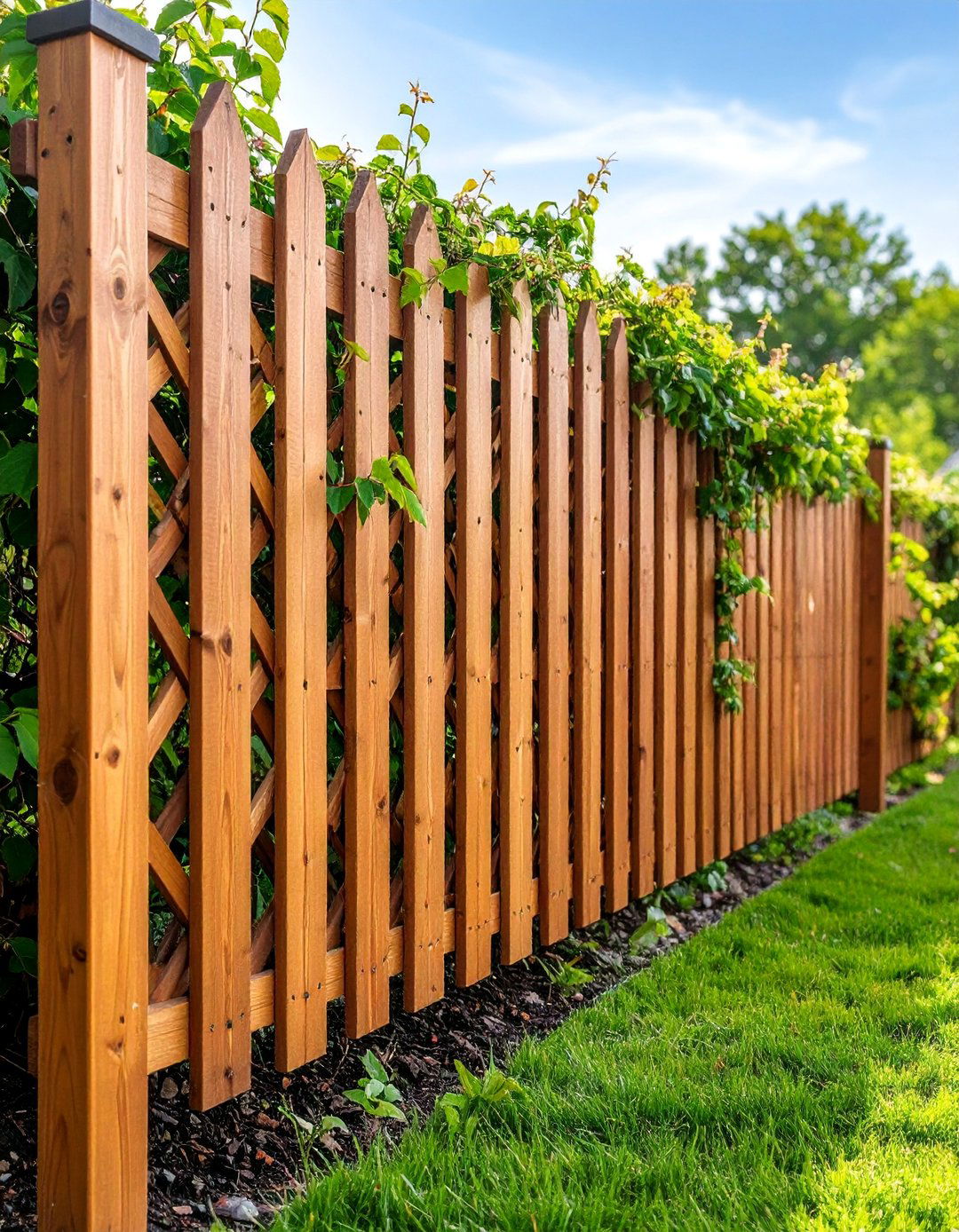


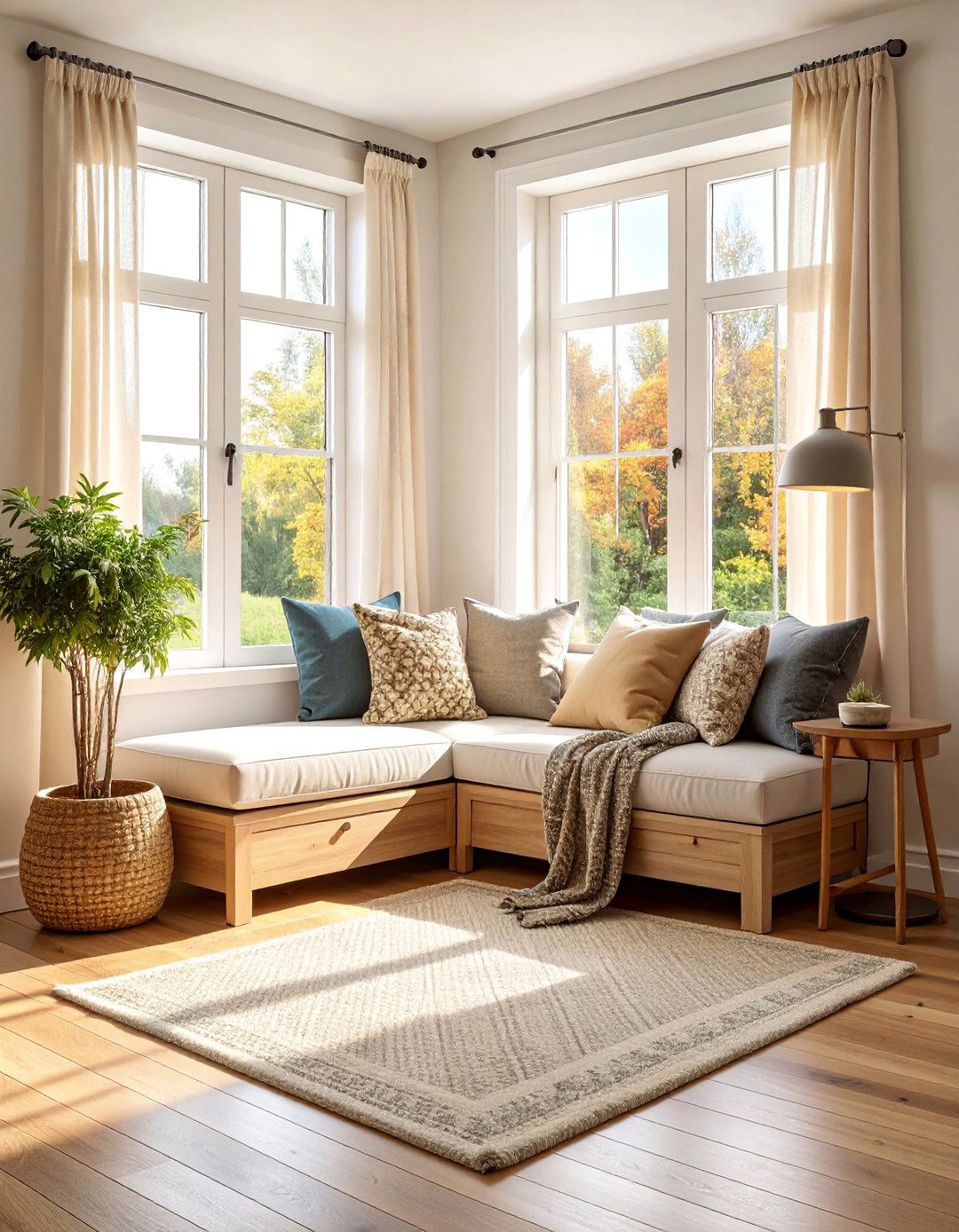
Leave a Reply